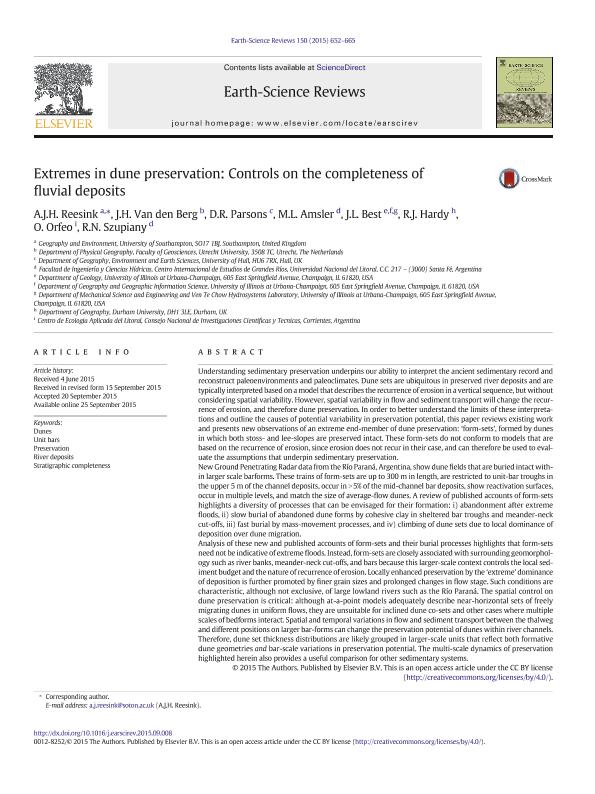Artículo
Extremes in dune preservation: controls on the completeness of fluvial deposits
Reesink, Arnold J.; Van den Berg, J. H.; Parsons, Daniel R.; Amsler, Mario Luis ; Best, James L.; Hardy, Richard J.; Orfeo, Oscar
; Best, James L.; Hardy, Richard J.; Orfeo, Oscar ; Szupiany, Ricardo Nicolas
; Szupiany, Ricardo Nicolas
 ; Best, James L.; Hardy, Richard J.; Orfeo, Oscar
; Best, James L.; Hardy, Richard J.; Orfeo, Oscar ; Szupiany, Ricardo Nicolas
; Szupiany, Ricardo Nicolas
Fecha de publicación:
09/2015
Editorial:
Elsevier Science
Revista:
Earth-science Reviews
ISSN:
0012-8252
e-ISSN:
1872-6828
Idioma:
Inglés
Tipo de recurso:
Artículo publicado
Clasificación temática:
Resumen
Understanding sedimentary preservation underpins our ability to interpret the ancient sedimentary record and reconstruct palaeoenvironments and palaeoclimates. Dune sets are ubiquitous in preserved river deposits and are typically interpreted based on a model that that describes the recurrence of erosion in a vertical sequence, but without consideringspatial variability. However, spatial variability in flow and sediment transport will change the recurrence of erosion, and therefore dune preservation. In order to better understand the limits of these Interpretations and outline the causes of potential variability in preservation potential, this paper reviews existing work and presents new observations of an extreme end-member of dune preservation: ?form-sets?, formed by dunes in which both stoss- and lee- slopes are preserved Intact. These form-sets do not conform to models that are based on the recurrence of erosion, since erosion does not recur in their case, and can therefore be used to evaluate the assumptions that underpin sedimentary preservation. New Ground Penetrating Radar data from the Río Paraná, Argentina, show dune fields that are buried intact within larger scale barforms. These trains of form-sets are up to 300 m in length, are restricted to unit-bar troughs in the upper 5 m of the channel deposits, occur in >5% of the mid-channel bar deposits, show reactivation surfaces, occur in multiple levels, and match the size of average-flow dunes. A review of published accounts of form-sets highlights a diversity of processes that can be envisaged for their formation: i) abandonment after extreme floods, ii) slow burial of abandoned dune forms by cohesive clay in sheltered bar troughs and meander-neck cut-offs, iii) fast burial by mass-movement processes, and iv)climbing of dune sets due to local dominance of deposition over dune migration.Analysis of these new and published accounts of form-sets and their burial processes highlights that form-sets need not be indicative of extreme floods. Instead, form-sets are closely associated with surrounding geomorphology such as river banks, meander-neck cutoffs,and bars because this larger-scale context controls the local sediment budget and the nature of recurrence of erosion. Locally enhanced preservation by the ?extreme? dominance of deposition is further promoted by finer grain sizes and prolonged changes in flow stage. Such conditions are characteristic, although not exclusive, of large lowland rivers such as the Río Paraná. The spatial control on dune preservation is critical: although at-a-point models adequately describe near-horizontal sets of freely migrating dunes in uniform flows, they are unsuitable for inclined dune co-sets and other cases where multiple scales of bedforms interact. Spatial and temporal variations in flow and sediment transport betweenthe thalweg and different positions on larger bar-forms can change the preservation potential of dunes within river channels. Therefore, dune set thickness distributions are likely grouped in larger-scale units that reflect both formative dune geometries and bar-scale variations inpreservation potential. The multi-scale dynamics of preservation highlighted herein also provides a useful comparison for other sedimentary systems
Palabras clave:
Dunes
,
Unir Bars
,
Preservation
,
River Deposits
,
Stratigraphic Completeness
Archivos asociados
Licencia
Identificadores
Colecciones
Articulos(CECOAL)
Articulos de CENTRO DE ECOLOGIA APLICADA DEL LITORAL (I)
Articulos de CENTRO DE ECOLOGIA APLICADA DEL LITORAL (I)
Citación
Reesink, Arnold J.; Van den Berg, J. H.; Parsons, Daniel R.; Amsler, Mario Luis; Best, James L.; et al.; Extremes in dune preservation: controls on the completeness of fluvial deposits; Elsevier Science; Earth-science Reviews; 150; 9-2015; 652-665
Compartir
Altmétricas



